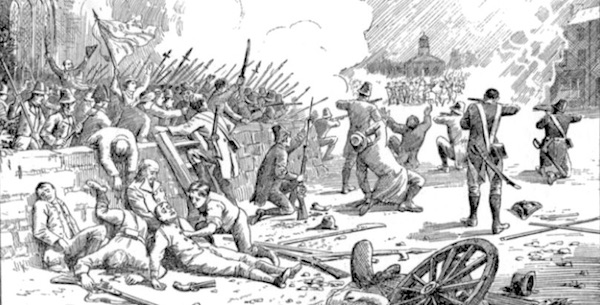
A look at the 1798 battle between British troops and Irish rebels led by Henry Joy McCracken, as delivered at his annual commemoration last weekend by RNU Vice-Chairperson Nathan Stuart.
Comrades, I’d like to start off by thanking you for the honour of speaking today. Irish Republicans of various stages of the struggle have studied the ideals and actions of the United Irishmen, in order to better understand and develop their own ideology, and we are no different. The Scottish Marxist and Irish Separatist James Connolly claimed, “Tone built up his hopes upon a successful prosecution of class war”. Peadar O’Donnell, an IRA volunteer who would side with the anti-treaty forces stated, Tone saw “the poor as the freedom force of the nation”.
This belief in the working class as the force of radical change in Ireland is even reflected in the battle of Antrim, which Henry Joy led. Henry was elected, by popular election, as adjutant-general and under his youthful radical leadership the planning of insurrection soon took place. He called for a general uprising across the province of Ulster on the 7th of June. He sought to liberate the town of Antrim, with the element of surprise securing victory for the Irish separatists.
Unfortunately, the commander of British forces in Belfast, General Nugent, was well aware of the planned uprising, no doubt due to the actions of native spies and informants. It was Nugent that then ordered the commander of the local garrison, Major Seddon, to prepare for battle against the Irish radicals. In preparation for the planned uprising the major carried out a ruthless campaign against suspected Republican sympathisers. Through mass arrests and through the burning down of homes and properties, he aimed to send out a warning to those that still sought to defy British rule.
Seddon began preparation for the upcoming confrontation, organising the Massereene yeomanry cavalry, the 2nd Dragoons and local loyalists, with incoming support en route to the battle from General Nugent, some 1000 men equipped with modern war machines; musket, cannon and howitzers. Of McCracken’s men, although a larger force, only one fifth were equipped with a firearm, the majority, wielding pike or farming utensil. It was these under equipped, untrained men, formed from the ranks of Ireland poorest, which faced the professional cavalry and cannon ball of the British Army in the fighting at the Battle of Antrim.
Due to the military’s knowledge of the uprising, the rebels marched unknowingly into the exact street where Major Seddon had positioned his cannons to fire. However in a twist of fate the cannons could not aim at the United Irishmen due to the Major’s own actions, the air surrounding the town had filled with smoke due to purge suspected rebels through flame.. The vision of the cannoneers had been obscured by the Major’s own cruel tactics. The United Irishmen marched unhindered.
William Lumley, lieutenant colonel of the 22nd Dragoons then ordered the cavalry charge against the Revolutionaries, he was bested as the pikemen of the United Irishmen hastily formed a wall of pikes to answer his charge, flanked by firearm wielding Irish rebels, the professional soldiers of Britain took heavy losses at the hands of landless labourers and of farm hands. This charge cost the lieutenant colonel 5 officers and 47 men, over a third of his entire force. McCracken had also during the fighting placed his musketeers in range of the British cannoneers, sniping at their position until they were forced to abandon their war machinery.
Despite these initial military successes, the troops under Henry’s command were unwilling to make a frontal assault against the trained soldiers of the British empire, the desertion of valuable reinforcements from Randalstown and fear of ensuing cannon fire cost the rebels a valuable victory.
As we here gather around this graveside, the graveside of the leader of these soldiers of Ireland, it is important we learn from their failings as well as their successes. That we must remain steadfast and confident in confrontation with forces that may appear far greater than our own. We must have faith in our own capabilities and strengths to achieve victory.
That it was a movement of the working class that caused the retreat of the cavalry that day, it was the persecution of political dissent that tipped the battle in the favour of Republicanism. So as we go about our day to day political struggles we must remember that the working class are not only capable, but are the only force can successfully challenge imperialism. And as Major Seddon was to learn, the tactics of brutality and of persecution only strengthens the cause of liberty and social change.
Remember this comrades when you suffer the worst excesses of the draconian policies of the British and their native allies. Our goals are not only achievable but their realisation inevitable. An Phoblacht Abu.
![[Irish Republican News]](https://republican-news.org/graphics/title_gifs/rn.gif)
![[Irish Republican News]](https://republican-news.org/graphics/title_gifs/harp.gif)

